Are you struggling to find the best Orange amp for metal? Then, you’re in the right place.
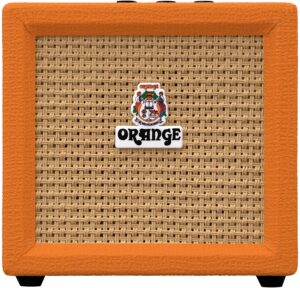
Not only is the Orange look, with its creative framing and bright Orange covering and classic logo styling, highly sought after, but the sound that these amps produce is often considered amongst the best for heavy metal.
This guide will provide tips and reviews to find the best small Orange amps for metal.
It is important to note that we decided to concentrate on small practice amps only. Huge Orange amplifiers used for live performances by professional musicians are a different story.
The 5 Best Orange Practice Amps to Play Metal:
| Image | Model | Price |
|---|---|---|
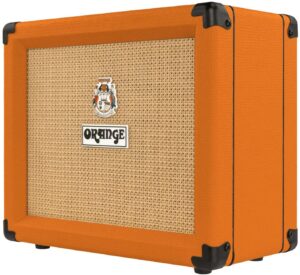 | Orange Crush 20RT (Top Pick) | Check Price |
 | Orange Crush Mini (Best on a Budget) | Check Price |
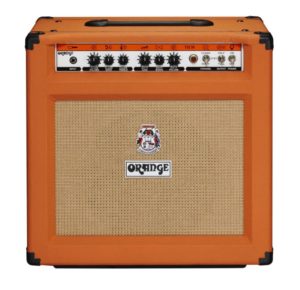 | TH30C | Check Price |
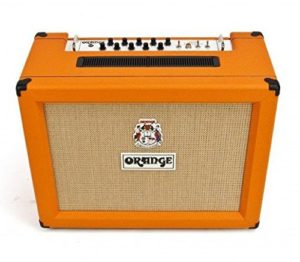 | AD30TC | Check Price |
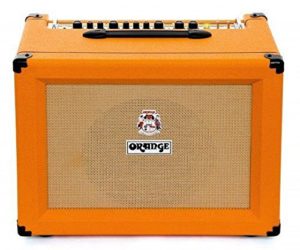 | CR60C | Check Price |
1. Orange Crush 20RT Amplifier (Editor’s Choice)
This cost-effective Orange amplifier will satisfy your thirst for gut-punching tone, excellent levels of detailed saturation, and a highly responsive overdrive. It features two-foot switchable channels, and the amp offers a gigantic wide-ranging tone.
The Crush RT amp will take you to the old school time of amplifiers. Moreover, it also offers Orange’s innovative CabSim circuit that perfectly emulates an Orange 4×12″ cabinet through 20RT’s headphone/line output, reverb, and onboard tuner. This is a perfect guitar combo amplifier.
This amp is easy to install, and you can plug in the amp, plug in your cord and turn on the rocker switch. It has straightforward control settings. The Orange Amp has a dirty and clean switch along with dirty/ clean volume knobs, followed by mid, treble, bass, and gain tones. It has a tuner on/off button, a reverb knob, ¼ inch headphone port, and an aux port.
The Crush 20RT is a fantastic portable amp that is a perfect combination of classic Orange mojo and the legendary Orange tone. The reverb in the Crush RT model adds 3D spaciousness to the sound. The analog dry-through of the circuit ensures your instrument’s tone. The chromatic tuner is fast-tracking and accurate for quick-ups between jams.
Pros
- Sounds amazing
- Long-lasting
- Easy installation
- Lightweight and small
- Great for metal
Cons
- None
2. Orange Crush Mini Amplifier (Best on a Budget)
Orange created this micro amplifier to give an amazing classic Orange tone in the lightweight mini amplifier. This Orange Crush Mini amp is an ideal companion whether you are practicing at home or warming up a small backstage.
The control panel is redesigned to give full tone control with shape, volume, and gain. British crunch is obtained by pushing the volume up and backing off the gain. When the gain is pushed up, it results in ample amount of gain. The shape control increases or lowers the mids.
The 8 Ω speaker output of the Crush Mini makes it unique. Using the amplifier’s preamp stage, you can directly plug into an external speaker, which opens more tonal capabilities. It has a built-in tuner and a headphone output that assists in silent practice by cutting off the speaker. Playing along to the song of your choice is a breeze with AUX IN.
When you make the gain and volume up, it sounds fantastic. There is one channel, and cleans are quiet. When volume is back off, then it growls and offers a cleaner sound. This product is impressive for rock and roll legends. You will love them for sure.
This tiny package of classic Orange amp performs like a real amp; however, it may cost you a little more than other mini amps available for practice sessions on the market. It’s one of the cheapest Orange amps you can get, on the other hand.
Pros
- Very Portable
- Great Product
- Versatile
- Optimum sound quality
- Good for metal
Cons
- Some customers have faced an issue when it is operated through a wall socket adapter
3. TH30C Amplifier
This model can be considered the portable version of the one above. The TH30C features a single 12″ Voice of the World speaker in a similarly engineered enclosure.
This amp’s two channels essentially make it a combo of the Rockerverb (Channel 1) and the Thunderverb (Channel 2).
I like what I have heard from the tone-shaping capability of the dirty channel. The four-tone shaping knobs allow you to fine-tune your crunch.
If I was to recommend one of these amplifiers to a gigging guitarist, the portable 1×12″ design makes this amplifier the one to beat. It is just so portable without sacrificing too much in terms of presence and forcing no sacrifice in metal sound we all love so much.
There may come a time where you are playing a venue that is just a little bit too large for this amp to cover with the same warmth and tone that it used to.
However, there may come a time where you are playing a venue that is just a little bit too large for this amp to cover with the same warmth and tone that it used to.
4. AD30TC Amplifier (Close Runner-Up)
The AD30TC can be considered one of the top-end tube amps that you can buy.
Featuring that iconic Orange styling, a classic open-back 2×12″ design, and 2 Vintage 30 speakers, you are getting the warmest of the warm and the fullest of the full while still being able to crunch if you want.
The twin channel design is a blessing. You can have a clean and dirty channel that each have their signal paths. So, a buttery smooth tone or a crunchy growl are each just a plug away.
Channel 1 brings that great creamy tone that recalls the old-school clean tube sound with some bark added for the modern era. Channel 2 is slightly bouncier and more top-end heavy, giving it a little extra bite. However, both channels offer a sound that truly is a joy to hear.
This amp is sure to please even in the largest bar. The engineers acoustically design the 13 ply plywood enclosure at Orange to produce the best sound from the great speakers in the housing.
Testimony to this amp’s quality is that the previous iterations were so successful worldwide that the amp specs have remained unchanged.
The downside is that the two speakers produce a lot of metal sound, and it may not be ideal for the practice room, especially if the other players’ practice gear is not up to snuff. But, if you have the money to drop on this beauty, you will not be disappointed.
5. CR60C Amplifier
In turn, away from tube amps, Orange made its first leap into the all-solid-state design with the Crush amplifier line. This particular model is the 1×12″ 60-watt design.
The cabinet’s design is similar to the TH30C. It has a single 12″ Voice of the World speaker, and like all Orange amps, the enclosure is acoustically engineered to the utmost specifications.
According to Orange themselves, this amp is designed on the legendary Rockerverb range. Like that range, the clean channel is a two-stage two-band design and produces extremely warm and smooth sound until pushed when it begins to break up.
The dirty channel is based on a four-stage three-band EQ design that offers all kinds of overdrive shaping abilities.
Additionally, the effects loop on this amp allows you to confidently add your own effects pedals to the mix and know that the sound will still be great.
It is a blessing on gigs or in recording sessions for any metal band. Knowing that you can trust the sound of your pedal setup through your amp is a weight that no guitarist should have to feel.
The CR60C is amongst the best in solid-state amplification for metal. It offers a price tag that is not quite as shocking as all-tube amplification. However, it will not quite stand up to the warmth of a tube amp.
So, bear that in mind when it comes time to pull the trigger.
Are Orange Amps Good for Metal?
Traditionally Orange amps have been low to mid-gain rock amps, and high gains amps developed recently are more metal-oriented. As a result, modern Orange amplifiers are somewhat Marshally-sounding like classic British-style medium gain amps.
Orange amps are commonly associated with heavy, slow riffs; this type blows your car speakers and knocks the teeth filings. Here we have mentioned the experience of some metal artists about Orange Amps.
Caleb Shomo, an American singer, songwriter, and multi-instrumentalist, used Micro Dark in the studio. It has been a fantastic tool, and it takes pedals great and can be violent or transparent as required. He used it for the pushed crunchy sound, and for that sound, the amount of volume needed is between 50 or 100 watts. The orange amp has a low end and the air that is required. It is loud without being offensive to the neighborhood.
Khemmis, an American band, used a pair of Rockerverb 100 MKIII heads, one into an Atlas 2×12 + 1×15 and Orange 4×12 for all the guitars on Desolation. He incorporated more complex chord shapes, so he began using RK100. The Rockerverbs yield lead sounds and gnarly rhythm. The clean tones were articulate and glassy.
Chron Goblin is a rock and roll band that released ‘Here Before’ in 2019. The album has organic and real-sounding, avoiding as much as possible the usage of digital enhancements. The band focuses on capturing the organic input to avoid the output editing with after effects. The band used Rockerverb MKIII and Orange15. There were no other guitar pedals and minimum after effects.
The band has conscious efforts to have a very moderate gain and treble to ensure clearly defined notes with a vicious bite in tone. They used the Jimi Hendrix approach for all clean guitar sections rather than a clean channel. The band turned down the tone knobs and volume of the guitar creating a toned down, warm, clean sound and keeping the gain channel settings intact. As a result, the outcome is honest and very organic throughout.
Monolord is a Swedish doom metal band that released New Comfort in September 2019. For bass, they used AD200B into an Orange OBC810. The bass tones are clear and thick with lots of string. Rhythm guitars were set down with one OR100 into the PPC412HP cab. Everything for the lead guitar was recorded with the Black Country Customs Tony Iommi Boost and sometimes with other overdrives through the PPC112 and the Micro Dark. The tone is angry in the low-mids.
It is commonly believed that the comeback of Orange in the ’90s was because of Noel Gallagher using the amp in Oasis. This is accurate to some extent because the Orange OR120 guitar amp features therein. Matt Pike used a Matamp and OR 120 on Holy Mountain. For all stoner rockers, these vintage orange amps are a must-have.
What Is the Difference Between A Tube And a Solid-State Amplifier?
There are two fundamental types of amplifiers. First, they are designated by using vacuum tubes or digital components to amplify and shape sound.
Whether or not there is any advantage to one type of amplifier often differs between types of guitarists, genre desired, versatility, and cost. As a general rule, tube amps are fiddly and costly but produce a full and warm sound.
Tube amplification also requires paying a premium price due to the care and skill required to assemble the amplifiers.
When buying tube amplification, something to consider is that if you ever have a significant problem with your amp, you may have to seek more costly repairs simply because your amp requires more skill to repair.
On the other hand, tube amps can often be great projects to learn more about tubes and how amplification used to be done.
Another downside to tube amplification is that some tube amps require the tubes to “pre-heat” before the amp is officially ready to be played through. But that tube sound is so worth it.
Solid-state amplifiers, which use digital components to shape and amplify the sound, are often cheaper and produce a slightly less full sound to some ears.
Orange also produces a “hybrid” amplifier, which uses a vacuum tube to shape the sound and digital components to amplify.
Some consider this amplifier style a good compromise between a tube amp’s natural fullness and the cost-effectiveness and predictability of sound across the same model’s amps.
Tube amplification often brings a level of musicality that has yet to be reproduced by digital amplification. Still, digital amplification is reliable and reproducible across each amp of the model series.
Tube amps are powered by expensive and sometimes breakable tubes. Solid-state amps are powered by much more cost-efficient digital circuitry that is cheaper to repair and less prone to breaking.
The rule-of-thumb is that if you have the money, tubes offer a sound with that particular something, whereas higher-end solid-state amplification offers slightly less musical sound for much less cost.
Speaker Configuration
The quality of the speaker also has a significant effect on the sound. More clearly, the best tube amplification through a lousy speaker will sound worse than decent solid-state amplification through a great speaker.
When I say “great” speakers, I partially refer to each speaker’s size and number.
Like larger strings or larger drums, larger speakers offer a lot more low-end yet slower response. Conversely, smaller speakers offer less in the area of low-end but more articulation and quicker response.
The “sweet spot” for guitar amps can be considered anywhere from 10″ to 12″. However, it isn’t unheard of to see amps with speakers of slightly different sizes offering quality sound.
The number of speakers in a combo amplifier can affect volume perception and the presence of sound. If you have more speakers in your cabinet, you will often cover more sonic “space” and feel louder than a single speaker.
If one were to choose a 2×12 amplifier, it would fill a large room with less effort. However, it would also be wise to pick up a more miniature amplifier for practicing purposes was filling up large venues is not such a concern.
Even still, a 2×12 is probably unnecessary for most players if they plan to go through a house sound system. That would help cut costs. However, if one goes with a 1×12 and has to fill a medium to a large venue, the amp may struggle a little bit when it comes to the presence of sound.
The only way to determine what speaker configuration you need is to determine what playing you will be doing.
If somebody is looking for a good amplifier for practicing and playing bars, a 1×12 would be the best compromise without purchasing a smaller amp for practice sessions.
The Best Orange Amp for Metal: Our Verdict
Forced to pick a winner, I would go with the Orange Crush RT20 amplifier because it is more powerful than the Crush Mini. The portability is an irreplaceable feature for the gigging musician. The point of music is sharing it with people at the end of the day.
But, if the price tag is just too high, the Orange Crush Mini amp will offer a competitive sound with a less shocking price tag. The sound will not be as warm, but the cost-effectiveness is higher, in my opinion.
Orange offers some of the best amplifiers for electric and bass guitars that money can buy. In addition, they offer a wide range of products that allow musicians at all levels to purchase an amplifier they can confidently plug into.
Apart from our two winners, I included three more models you can call “the best compact Orange amps for metal” or something like that. These amps are also great for practice, but they are much more expensive and should be alternatives only if you are not on a budget.